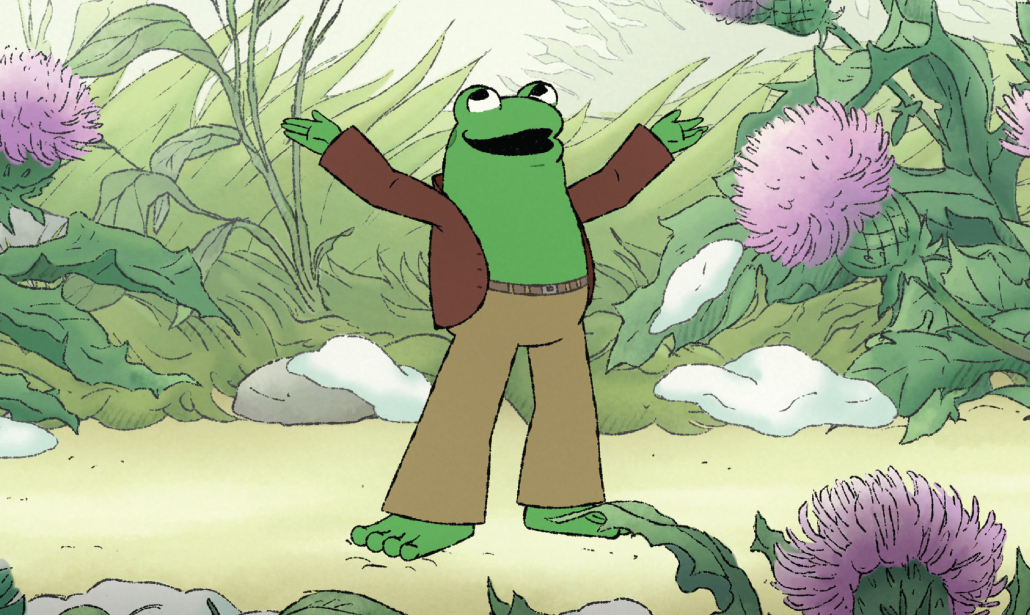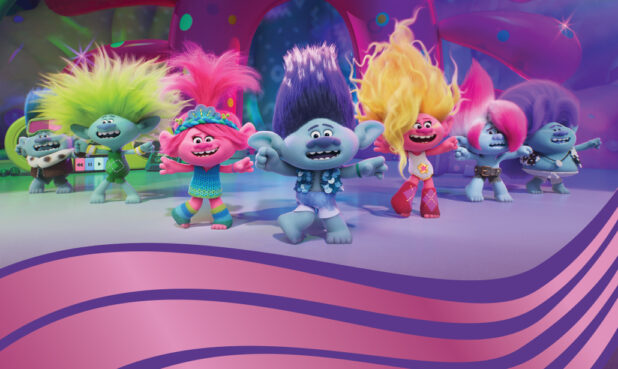Whether it’s frog and toad best friends, a monkey with supernatural powers, or a family of loveable sharks, “creating anthropomorphic animal characters is something that humans have been doing for a long time,” says Cheryl Johnson, Art Director on Nickelodeon’s Baby Shark’s Big Show! “We love to see ourselves in animals.”
Whitney Ralls, Executive Producer and Head Writer on Baby Shark’s Big Show! and Script Writer for Baby Shark’s Big Movie, agrees. She says that this has its roots in ancient mythology, the way we tend to take things that are “very animalistic, but looking at them through a human lens.”

As for how to accomplish that in animation, it’s about finding the happy medium. With details like the ears, nose, whiskers, and feet, the more animal-like, the better. But the more expressive the face, mouth, and eyebrows can be, “the easier it’s going to be to relate to those characters,” Johnson says.
Take a shark, for example. “It can be tricky, because you don’t want to have too many big pointy, scary teeth,” says Johnson. So her team made the sharks’ teeth a bit chunkier and gave each shark its own uniquely-shaped teeth to differentiate it. These tweaks made for friendlier creatures.
For the Titmouse/Apple TV+ series Frog and Toad, based on author and illustrator Arnold Lobel’s much-loved books about a friendship between two amphibians, Executive Producer and Head Writer Rob Hoegee notes that all of the characters in the show are animals and their names reflect exactly what they are. “Frog is a frog, Robin is a robin, so they’re inherently animal,” says Hoegee. “That being said, they talk. They wear clothes. They cook breakfast. Most of them live in houses.” As well, Frog and Toad is largely about feelings and emotions. To convey this and humanize them, the animals do things that you don’t see animals doing in the real world, such as smiling, laughing, and crying.
“The minute you give an animal character a solid, dark eye … it’s going to instantly feel more animal-like and be a little bit harder to relate to.” —Cheryl Johnson
In the book series, while Frog and Toad are already more like humans, the other animals “really felt just like critters,” says Supervising Director Sarah Johnson. A conscious decision was made to humanize Frog and Toad even more, while keeping the other animals somewhat humanized and leaning more into their animal qualities. It was a fine balance because they didn’t want to lose the idea that this is Frog and Toad’s world. “While we would have Mouse run in and out on all four legs and do little mousy actions, I never wanted to see Frog and Toad hopping along the ground like animals, because that would feel inherently weird,” says Johnson. That said, they did want to convey some of their more nuanced animal aspects, such as the tongue flicks added to Toad by Storyboard Artist Amy Mai.
Drawing Inspiration
References are always an essential part of creating any animated character. Inspired by a centuries-old Chinese tale, the Netflix action-comedy film The Monkey King follows a monkey and his magical fighting stick on an epic quest to fight gods, dragons, and his own ego. Director Anthony Stacchi says that from descriptions in the original text, the monkey is roughly based on a macaque that is common in southern China. That served as a research starting point, but they wanted him to feel more special than the other monkey characters. They gave him a deeper red color and a long, pompadour-like hairdo, as well as specific markings on his face and hands that were inspired by the make-up in Peking opera.
While there is a distinctive look to traditional Chinese dragons, Stacchi says they tried something different with the Monkey King’s adversary, the Dragon King. Even though it’s a mythical creature, Animation Supervisor Rune Bennicke says that they did research on real reptiles. They looked at the “Jesus Christ Lizard” as a reference. This lizard runs on water and has a slightly awkward way of running. Bennicke says that was an important attribute to work into the Dragon King, since he is uncomfortable on dry land and travels around in a tub when he’s out of the water.

Similarly, when approaching the underwater sea creatures on Baby Shark’s Big Show!, Cheryl Johnson advised her artists to look at the real animal first and to identify those key animal features. For sharks, that would be the fins. You have to make sure they’re in the right place and that you give the sharks a streamlined body as well. “Sharks have a very distinct silhouette, and each species of shark has a slightly different silhouette,” she says. “So if you can include those details, while making them a little bit rounder, a little bit more friendly, it will make it feel like a good blend of an animal [and human].”
For Frog and Toad, characters who are already very humanized, Sarah Johnson, who is a self-proclaimed herpetology nerd, says she “wanted to lean in to the inherent differences of Frog and Toad.” Not just through their personalities as portrayed in the books, but she also wanted to “lean into Frog being more ‘froggy’ and Toad being more ‘toady’” and finding ways to show the differences between these two creatures. This meant that “Frog could do bigger jumps and bigger leaps. He was springier,” she says. “And Toad is very much more flat on his feet.”
Get a Move On
Tasked with figuring out how to move the Monkey King, Bennicke says they learned that monkeys are quadrupeds, so they don’t walk on their knuckles like chimpanzees, but instead walk with their palms down. Monkeys also walk upright with a slight bend to the back, with the elbows a little bit out, and with a bend in the knee.
In the beginning of the movie, just after he’s born, the Monkey King is surrounded by real monkeys who all move like monkeys, and he uses his arms to run. But as he becomes more godlike and powerful, he stands up straight and starts moving more like a human. That said, they focused on the Monkey King’s posture “so that he’s never standing up completely straight, because that would always tend to look [too] human,” Bennicke says. And occasionally he’ll still go down on all fours to run faster.

The Monkey King’s movement is a combination of “real” monkey movement, from when he is seen as a baby monkey, combined with Peking Opera-influenced and martial art-inspired posing when he is an adult. Bennicke says that despite having expert help with fight choreography, one of their biggest challenges was animating the action scenes. With martial arts, he explains, it’s all about the tensing and relaxing of muscles and movements. “One of the hardest things to do in animation is to get … a sense of power into something,” he says. He adds that the Monkey King is a lot more athletic than any actual martial artist, because apart from being a monkey, he has supernatural qualities. “We can jump him more, we can spin him more, he has a tail that he can use when he’s fighting.”
-

The complexities of animating movement were taken into consideration when clothing, or not clothing, characters in Frog and Toad. -

“As far as clothes go, if it looks weird, no clothes.” — Rob Hoegee
For movement in Frog and Toad, Hoegee says his team really wanted to tap into the nostalgia of the books and make it look as if the illustrations had come to life. To honor Lobel’s art, they mimicked scenes and poses whenever possible. But this meant they had to figure out how the animals moved and how they were articulated based on still illustrations.
Another issue was wardrobe for the supporting animal cast. “As far as clothes go, if it looks weird, no clothes,” Hoegee says. This was the case when they tried to dress a snake character, so Snake didn’t get clothes. “And clothing for Robin would interfere with how wings work and how she flies,” he says. They compromised by giving Robin a little hat. Mouse didn’t get clothes either because he sometimes runs on all fours and the clothes would interfere with his movement. Sarah Johnson explains that there were also instances when they had to use cartoon logic to get around certain situations. For instance, Snail delivers mail. The character is limited because she doesn’t have arms or hands, so they let her use her mouth to move things.
Ralls had a similar experience with the undersea creatures on Baby Shark’s Big Movie. The characters don’t have hands so how do they pick things up? And they don’t have thumbs so they can’t give each other a thumbs up. Because of this, she encouraged the writers to think about how feasible it is for a character to do certain actions to pre-empt issues down the pipeline.
Hey, Big Mouth
Mouth movements on speaking animals can present their own difficulties. Cheryl Johnson says that for Baby Shark’s Big Show! they have a system in place for building mouth charts for most characters to accommodate all the phonemes they need to say. Where possible, they will try to stick existing mouth charts on new characters if it works with their design, but whenever they add a character that has a unique mouth shape, they have to build a new chart that usually includes a front-facing view, a three-quarter front, and a side view. It’s a lot of tedious work, she says, but it’s absolutely essential.
With human characters, she explains, you can build a theme that you can reuse across different faces, but that’s not possible with animals ranging from dolphins to crabs because their faces are all so different. In the show they’ve had to make the mouths more human because it’s easier and works better with their character designs to make them more appealing.
Frog and Toad’s mouths were also problematic, according to Sarah Johnson. “Early on, we were trying to avoid them looking straight on at the camera and speaking at all, because we were worried that it would just be a sea of black. It would be too dark because we’re emulating the book where the mouth-fill is all black scribbles.”
Mouse’s mouth was a challenge, as well—it’s so small that they didn’t give him an open mouth shape at all. “When he talks, it’s just his muzzle moving,” says Sarah Johnson. She believes this led to some really great body animation on Mouse because it forced the animators not to rely on the mouth shapes to get his expressions out.
With the Monkey King’s mouth, canines were a consideration, and the team debated how much to show because “immediately when you open somebody’s mouth and show canines then there is an aggressive feel to it,” says Bennicke. “But it was extremely helpful for the shots when the monkey is angry.”
Stacchi points out that it was especially complicated to animate the Dragon King with his long crocodile-like mouth. “The corner of the mouth has to travel so far for different mouth shapes—stretching the surface and the textures,” he says. They had to determine how far back and forward the corner could go “without [the mouth] chattering around so much that it looks distracting.”
Windows to the Soul
Cheryl Johnson pays close attention to an animal’s eyes. The more closely the eyes of the sharks resemble human eyes, the more relatable they are. In practical terms, “you usually want to have eyes with a lot of white around them, like ours, and a really clear pupil,” she says. “The minute you give an animal character a solid, dark eye, or a black dot eye, it’s going to instantly feel more animal-like and be a little bit harder to relate to.”
Baby Shark’s Big Show! Animation Director Crystal Stromer also emphasizes conveying emotion through eye movement. “A well-timed blink can just really hit home,” she says. If a character is sad or surprised, changing up the timing of a blink alone will say so much about how a character is feeling. “That’s what really telegraphs that these characters are alive.”
Along with more human eyes, they gave the sharks eyebrows to help with expressions, but in Frog and Toad, the characters don’t have eyebrows at all. To add emotion, Sarah Johnson says they had to lean on the animation team to push what they did have. The team made use of the under eyelids coming up and upper eyelids coming down to get more expression.

Sometimes, though, the element used to express emotion can take a surprising form. When writing for animal characters, Ralls says she likes to focus on something that’s unique to that animal. In Baby Shark’s Big Movie, for instance, they introduced a lantern shark named Lannie. Ralls explains that lantern sharks glow different colors. This led to the idea of the colors representing different human emotions.
In a sense, Ralls says, they were anthropomorphizing the colors to represent the human emotions that make Lannie a lovable, relatable character who is a bit all over the place because what she’s feeling is obvious to everyone. It also helps with the comedy because Lannie is always putting her foot in her mouth (proverbially) by revealing her true feelings in her glowing colors.
Another unconventional example is a sea urchin in Baby Shark’s Big Show! He was particularly challenging because he’s basically “a circle with some quills sticking out and like one eyeball,” says Stromer. “If he gets excited, we’ll shake his quills a little bit … or droop them to show that he’s sad.”
Be it a raised eyebrow, a well-timed blink, or quivering quills, there are myriad techniques that can bring animal characters to life to make sure audiences forge an emotional connection.











